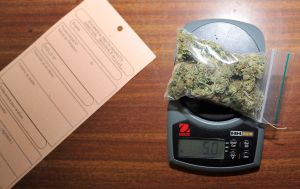
Source: PHILIPPE HUGUEN / Getty
More than half of Ohio’s population could become eligible in June for a medical marijuana card if the state approves five more ailments as qualifying conditions.
Among the proposed additions: depression and insomnia, which affect hundreds of thousands of Ohioans.
Since January, an advisory committee for the State Medical Board of Ohio has studied the five ailments and whether medical marijuana could help. The three other conditions under consideration are anxiety, autism spectrum disorder and opioid use disorder, the formal term that the medical board uses for opioid addiction.
Tiffany Carwile of Bryan, Ohio, has a 5-year-old son with autism. She is the Ohio chapter director of Mothers Advocating Medical Marijuana for Autism. Last autumn, when the state opened a window for residents to suggest conditions to add as qualifiers, Carwile prepared a 500-page document supporting medical marijuana for autism.
“Medical marijuana is not a cure for autism. I’m not saying this is going to cure my son. But I know it’s going to dramatically improve his quality of life,” Carwile said. “If some day he can say, ‘I love you, Mom,’ I will be the happiest person in the world.”
Some conditions allowed in Ohio are covered in other medical-marijuana states, such as cancer, Parkinson’s disease, epilepsy and glaucoma.
But Ohio also covers rarer conditions such as sickle cell disease, fibromyalgia and Tourette syndrome. Ohio also is the only state to permit medical marijuana to treat chronic traumatic encephalopathy, the traumatic brain damage most often found in boxers, football players and military veterans.
In July, an Enquirer analysis found at least 3.5 million Ohioans, or about three out of 10 residents, suffer from at least one of the 21 qualifying conditions and could apply for a medical-marijuana card. Ohio’s population is about 11.69 million.
If the medical board adds all five proposed conditions, the number of Ohioans eligible for a medical marijuana card will nearly double, with another 3.17 million people.
As it did in July, The Enquirer estimated the number of people potentially eligible for a medical marijuana card under the five proposed new conditions by consulting the Ohio Department of Health, the U.S. Centers for Disease Control and Prevention and private nonprofits that raise money for medical research.
Autism spectrum disorder
Number of patients: About 44,000 Ohio children. Children in Ohio can get a medical marijuana card under a parent’s authority. It’s not known how many Ohio adults live with autism.
Evidence: There’s little clinical research about effectiveness because there’s been little study since the federal government considers marijuana as dangerous as heroin. In December, the national organization Autism Speaks held a conference on the topic, and experts called for more study.
States that qualify this condition: Colorado, Delaware, Iowa, Louisiana, Michigan, Minnesota, Pennsylvania, Puerto Rico, South Carolina, Utah
Anxiety
Number of patients: About 1.6 million Ohioans
Evidence: There’s little clinical research about effectiveness because there’s been little study since the federal government considers marijuana as dangerous as heroin. A 2012 study by two California researchers said marijuana could be promising, but more study is needed.
States that qualify this condition: New Jersey, West Virginia
Depression
Number of patients: About 725,000 Ohioans.
Evidence: There’s little clinical research about the effectiveness of medical marijuana because there’s been little study since the federal government considers marijuana as dangerous as heroin. A 2018 study of responses to an Internet survey found that marijuana users reported less depression and anxiety.
States that qualify this condition: None
Insomnia
Number of patients: At least 860,000 Ohioans.
Evidence: There’s little clinical research about effectiveness because there’s been little study since the federal government considers marijuana as dangerous as heroin. A 2018 New Mexico study of 409 people responding to an Internet survey found a significant improvement in sleep.
States that qualify this condition: None
Opioid use disorder, or addiction
Number of patients: No one knows. No government or medical authority is counting.
Evidence: There’s little clinical research about effectiveness because there’s been little study since the federal government considers marijuana as dangerous as heroin. In August, The Enquirer examined the prospect of using marijuana for the condition.
States that qualify this condition: Illinois, New Jersey, New York, Pennsylvania
















